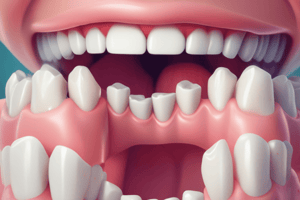Podcast
Questions and Answers
Which factor contributes to pulp exposures caused by caries occurring more frequently in primary teeth?
Which factor contributes to pulp exposures caused by caries occurring more frequently in primary teeth?
- Primary teeth have relatively large pulp chambers
- More prominent pulp horns
- Thinner enamel and dentine
- All of the above (correct)
What percentage of primary molars with proximal cavities experience pulp involvement?
What percentage of primary molars with proximal cavities experience pulp involvement?
- About 50%
- About 85% (correct)
- About 75%
- About 65%
Which diagnostic factor is important in the clinical condition of the carious tooth and its surrounding tissues?
Which diagnostic factor is important in the clinical condition of the carious tooth and its surrounding tissues?
- Presence of pain (correct)
- Size of the tooth
- Shape of the tooth
- Color of the tooth
Which type of pain, indicated by spontaneous throbbing and constant pain, suggests pulpal damage-irreversible pulpitis?
Which type of pain, indicated by spontaneous throbbing and constant pain, suggests pulpal damage-irreversible pulpitis?
What does provoked pain, stimulated by thermal, chemical, or mechanical irritants, suggest about the pulp?
What does provoked pain, stimulated by thermal, chemical, or mechanical irritants, suggest about the pulp?
What is the main cause of pulp exposure in primary teeth?
What is the main cause of pulp exposure in primary teeth?
What percentage of primary molars with proximal cavities experience pulp involvement?
What percentage of primary molars with proximal cavities experience pulp involvement?
Which type of pain indicates irreversible pulpitis and suggests that the pulpal disease has progressed too far?
Which type of pain indicates irreversible pulpitis and suggests that the pulpal disease has progressed too far?
What does provoked pain, stimulated by thermal, chemical, or mechanical irritants, indicate?
What does provoked pain, stimulated by thermal, chemical, or mechanical irritants, indicate?
Which diagnostic factor is important in the clinical condition of the carious tooth and its surrounding tissues?
Which diagnostic factor is important in the clinical condition of the carious tooth and its surrounding tissues?
Flashcards are hidden until you start studying
Study Notes
Pulp Exposures in Primary Teeth
- The higher prevalence of caries in primary teeth contributes to pulp exposures occurring more frequently in these teeth.
Pulp Involvement in Primary Molars
- Approximately 40% of primary molars with proximal cavities experience pulp involvement.
Clinical Diagnosis of Carious Teeth
- The clinical condition of the carious tooth and its surrounding tissues is an important diagnostic factor.
Pain Indicators
- Spontaneous throbbing and constant pain suggest pulpal damage-irreversible pulpitis.
- Provoked pain, stimulated by thermal, chemical, or mechanical irritants, suggests reversible pulpitis.
- Provoked pain indicates that the pulp is still responsive to stimuli, but irreversible pulpitis is indicated by spontaneous pain.
Main Cause of Pulp Exposure
- Caries is the main cause of pulp exposure in primary teeth.
Progressive Pulpal Disease
- Spontaneous pain indicates that the pulpal disease has progressed too far, suggesting irreversible pulpitis.
Studying That Suits You
Use AI to generate personalized quizzes and flashcards to suit your learning preferences.




